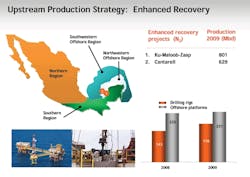Risk reduction techniques while drilling in crowded offshore environments
Bryan Daire, Theodore Eicks, Leo Jew - BP plc
Nitin Sharma, Mike McDonald, Jeffrey Mohammed - Baker Hughes
In offshore spar drilling where the slot availability is limited, anti-collision management has become an important aspect while planning and drilling the wells. This increasing trend in crowded offshore drilling for optimizing production means great emphasis on avoiding collisions with offset wellbores in developed fields. Collision with a producing well can cause a loss of well control, resulting in a significant impact on productive time and income from shut-in wells.
Well intervention for drilling a sidetrack utilizing whipstock has become a common practice. After setting a whipstock assembly and milling a window, enough rathole is drilled to land the bottomhole assembly (BHA) that will be used to drill the rest of the section. After exiting the window, the sidetrack will be under magnetic interference from the parent wellbore and nearby offset wells. This magnetic interference can impair conventional measurement while drilling (MWD) tools for a substantial drilled distance. Drilling blind after exiting the window may result in catastrophic results.
A recent case study by Baker Hughes and BP illustrated best practices for planning and drilling phases in developed fields to minimize these risks. The article puts emphasis on some of the techniques to reduce NPT and risk while sidetracking a well using whipstock in crowded drilling environment. Increased emphasis was placed on the following: whipstock placement and orientation to minimize the risk of collisions while reducing NPT; reducing directional uncertainty by using gyro MWD and single/multishot gyro tools while drilling near magnetic interference; and collision avoidance using the traveling cylinder plot and spider plot.
A case history provided illustrates the successful application of these techniques.
Whipstock placement
The kick-off point (KOP) depends on several factors, with the first related to the directional work required to reach the target. The most obvious option is to place the whipstock as close to the target as possible in order to minimize the length drilled, but this may cause the wellpath to have excessive doglegs which can cause problems while running casing or completions equipment. Selecting a higher sidetrack point can make drilling easier and give more room to make adjustments to the directional plan. Deeper sidetrack points usually mean less distance to drill and less expensive sidetracks. These deeper sidetrack points, however, also give more opportunity for future well intervention.
Formation strength is the second consideration in selecting the sidetrack location. Formations with high compressive strengths may have low rates of penetration (ROP) when drilling the rathole, and may require multiple mill runs to cut the window and drill the rathole.
Whipstock orientation in appropriate direction is critical, especially if the KOP is in a drop or a build section. Gravity and drill string rotation tend to force the milling assembly down and to the right. To avoid having a “casing lip” that could possibly prevent the BHA or casing from passing through, the best practice is to orient the whipstock to the high side of the wellbore to deliver a clean window and to avoid extra milling runs. The milling assembly should be designed to build away from the whipstock, transferring more cutting energy into milling the window instead of the whipstock.
Gyroscopic tools
Gyroscopic tools are mainly of two types, gyro MWD and gyro single/multi-shots. Gyro multishots are widely used for completion surveys and gyro MWD for drilling wellbores where magnetic interference can cause conventional magnetic MWD tools to become impaired. The biggest advantage of gyro tools while sidetracking a well is their utilization in orienting whipstock, drilling rat hole, and while drilling the section when influenced with magnetic interference. While drilling in a crowded environment, the importance of decreasing the positional uncertainty is apparent. Also gyro MWD is a more efficient tool to orient whipstock and while drilling the rat hole when the well is vertical or near vertical at the sidetrack point. On the other hand, gyro single and multishots are the only options to be used in RSS assembly when drilling through magnetic interference.
Anti-collision management
In spar drilling environment, many wells are drilled in proximity to each other, making a rigorous anti-collision procedure extremely important. The visualization of a 3D well profile is very difficult on conventional vertical section and plan view plots. These 2D visualizations often do not give a clear picture of the offset wells that may be close.
Traveling cylinder plot, spider plot
To visualize these 3D well profile, traveling cylinder plot is a very effective tool. It also gives a better understanding of a well’s position with respect to offset wells. The proximity of offsets wells can be illustrated in relation to the planned wellbore. These traveling cylinder plots are reviewed as part of the pre-well planning process and during the drilling phase. The traveling cylinder uses a normal plane to display the intersection of wells with a plane constructed in space at a right angle to the planned wellbore.
In this plot, the standard used by the service company and the client is to equate the 12 o’clock position with true north or grid north, not high side. All depths referred to in the plots are measured depth (MD). The calculation is repeated at any given number of points along the planned wellpath and these results are superimposed on the same diagram. The relative separation between the planned well and adjacent wells is indicated by the locus of points at successive depths.
The separation factor does not take into account the orientation of the ellipse of uncertainty. This can result in conservative well planning, which can at times be unnecessarily restrictive. To avoid this problem, pedal curve calculations are used that consider the perpendicular distance from the center of ellipses of the two wells.
To define and calculate the separation factor, pedal curve calculations are used that consider the perpendicular distance from the center of ellipses of the two wells. The function of the no-go line is to clearly show the region that the planned wellbore must not enter while at, or shallower than, the measured depth.
The planned well is required to have a minimum separation from any offset well at any particular depth of interest calculated by:
Spider plot
The spider plot is a conventional tool has used in the industry for years. It is a plan view of the planned wellbore along with offset wells. The actual well path is plotted based on true vertical depth (TVD) and north/east coordinates to find out deviation from the planned wellbore and proximity with the off set wells. A spider map, along with a traveling cylinder plot, is an optimum tool to plan a well and avoid collision during the drilling phase. If the planned wellbore intersects any offset wells at approximately the same TVD as the offset well, extra consideration should be given while drilling at the same depth.
Spider map is a more effective tool along with traveling cylinder plot to make the steering decision when needed.
Case history
Well A-1 ST#3
BP’sHolstein spar is in Green Canyon block 644/645 in the Gulf of Mexico. The spar was built with 20 slots, with 15 slots being used thus far to drill a total of 32 wells, including sidetracks. Well A-1 ST#3 was planned to drill a target far south of the spar’s surface location. The location of the target and the two previously drilled sidetrack wells resulted in sidetracking this well from the 133⁄8-in. casing. During the planning phase, all doglegs kept below 3.5°/100 ft (30 m) due to completion and casing operations. The anti-collision report indicated that the A-1 ST#3 plan had major risks with five nearby wells and their sidetracks. The magnetic scan also indicated that the well would be susceptible to magnetic interference from the parent wellbore to 8,800 ft (2,682 m) with a center-to-center (C-C) distance of 42 ft (12.8 m) and a no-go distance of only 10 ft (3 m). The minimum no-go distance with respect to the other offset wells ranged from 3 to 40 ft (1 to 12 m) from the sidetrack point to section TD. To get the sidetrack well away from the offset wells as early as possible, it was planned to build from vertical to 66° in approximately 2,400 ft (732 m) while turning to the left toward the target and away from the parent wellbore. The KOP was set at 8,295 ft (2,528 m) MD due to the fracture gradient and directional feasibility to the target.
Whipstock orientation
At 8,295 ft (2,528 m) MD the well was near-vertical at 0.38° inclination. With no high side defined in the wellbore, the whipstock had to be oriented with a gyro tool. The whipstock was set up and oriented at 90° (or 270°) to align the planned wellbore with the target. This also helped the sidetrack get away from the parent wellbore.
Gyro tool
Since the magnetic scan indicated that the well would be under magnetic interference for 500 ft (152 m) from the sidetrack depth and that there were tight no-go distances, the use of gyro tools was necessary to get clean surveys while drilling the first part of the section (from 8,295 to 8,800 ft MD). Gyro multishots were used for collision management and were landed on a universal bottomhole orientation (UBHO) sub installed in the milling assembly. The window was milled and rathole was drilled from 8,333 to 8,448 ft (2,540 to 2,575 m) MD. The UBHO sub was approximately 99 ft from the bottom of the milling assembly, so only three new surveys were taken down to 8,340 ft (2,542 m) MD. To determine the surveys for the rest of the rathole, a survey run was planned with a bit sub along with baffle plates to land the gyro multishots. The baffle plate was offset only 2 ft (0.6 m) from the bottom of the BHA, allowing surveys to be run much closer to the end of the rathole. A total of nine surveys were taken and plotted along with the earlier run on the traveling cylinder diagram. These surveys indicated that the sidetrack was getting away from the offset wells as planned. A rotary-steerable system (RSS) BHA was picked up along with an expandable reamer to do the directional drilling. This assembly was equipped with a reamer, so a baffle plate could not be installed to land the gyro. The gyro would be landed at the reamer to get more clean surveys before getting clear of magnetic interference. Four more surveys were taken with the gyro from 8,455 to 8,628 ft (2,574 to 2,630 m) MD. These surveys were also plotted on the traveling cylinder to make sure the sidetrack in the right direction.
Collision management
This well’s most crucial section, from a collision risk perspective, was the first section. The plan was to build and turn right from the beginning to achieve separation from the parent wellbore. During the planning stage, two traveling cylinder plots were generated along with nearby offset wells – one with 25 ft (7.6 m) C-C separation, and one with 125 ft (38 m) C-C along with a spider view plot. Once surveys while drilling were obtained, they were plotted as an offset well to the plan on the traveling cylinder. As crucial depths ranged from the KOP at 8,295 ft down to 10,500 ft (2,528 to 3,200 m) MD (according to the anti-collision report), each survey was plotted to visualize the wellbore placement. The first few surveys from the gyro tool confirmed that the whipstock was oriented in the desired direction, and the sidetrack was headed away from the parent wellbore and the other offset wells. The survey at 9,858 ft (3,005 m) MD plotted on TC indicated that the well was heading toward the no-go line for the A-15 well. All these survey points are also plotted simultaneously on the spider plot to confirm that the wellbore was following the plan closely. This allowed the sidetrack to be steered away from the A-15 ST#1 well while giving enough time to get the directional work done without generating excessively high doglegs. The well was steered away by changing the azimuth from 244º at 9,858 ft MD to 233º at 10,020 ft (3,054 m) to get away from the A-15 ST#1 well. The well was drilled to target depth with minimal deviation from plan and no excessive doglegs.
Conclusions
This article illustrates three techniques to reduce NPT and risk of collision while sidetracking a well using a whipstock in a crowded drilling environment as follows:
1) Describing best practices on whipstock placement and orientation.
Placement based on:
Depth
- Formation
- Directional drillability.
Orientation based on:
- Wellbore inclination
- Target location.
2) Use of gyro tools in the milling assembly and RSS assembly to avoid collision risk.
Gyro usage
- Vertical wellbores for orienting the whipstock
- Survey management and also to complement the anti-collision management criteria.
3) The importance of anti-collision management.
- Use of traveling cylinder plot
- Confirm the whipstock orientation
- Use of traveling cylinder and spider map
- To make steering decisions to avoid collisions.
Further emphasis has been placed on using the no-go line criteria on the traveling cylinder plot, which gives users the option to make changes in directional plans. The flexibility of the traveling cylinder diagram enables efficient directional drilling without posing an unacceptable financial risk for the participants. The importance of gyro tools and their application for survey management and anti-collision management criteria has also been stressed.
Editor’s note: This article was based on findings presented in paper SPE 124246-PP at the Oct. 4-7, 2009 SPE Annual Technical Conference and Exhibition in New Orleans, Louisiana with updates from the authors.






